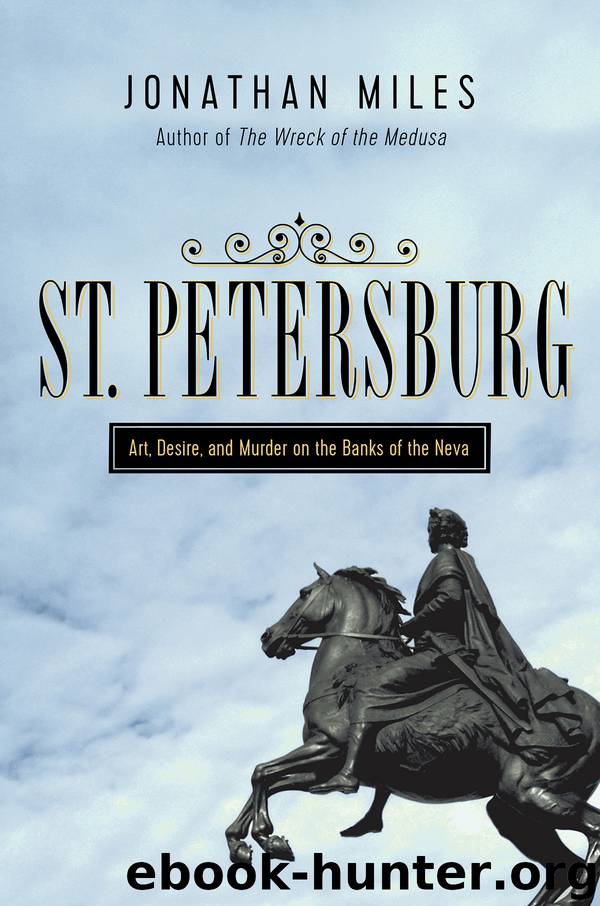St. Petersburg by Jonathan Miles

Author:Jonathan Miles
Language: eng
Format: epub
Publisher: Pegasus Books
Massacre in Palace Square on ‘Bloody Sunday’, 1905.
Kokovtsov managed to get out by mid-afternoon and noted that the demonstration had been effectively broken up. There were stragglers rioting and looting, but Gapon – still intending to press on to revolution – was in hiding. The official figure was kept low, but the toll of dead or badly wounded on ‘Bloody Sunday’ was close to 1,000 – the foreign press had ‘thousands’. As with the numbers of those who perished while building the city, an accurate figure is difficult to determine.45 In any case, statistics only tell so much. The tension, hope and despair of Bloody Sunday the march, the massacre – survive in Dmitri Shostakovich’s IIth symphony, ‘The Year 1905’.
That Sunday evening there was a benefit performance at the Mariinsky for the ballerina Olga Preobrajenskaya. While the performance went ahead without a hitch, rumours of insurrection rippled through the audience and the theatre began to empty. Karsavina remembered walking home afterwards with her brother and finding the streets strangely ‘quiet and empty’. Across the globe, however, the headlines shocked readers, and Kokovtsov – in the process of negotiating loans with Paris and Berlin – faced the difficult task of reviving the market’s faith in Nicholas II’s Russia. Although the capital swiftly returned to a semblance of normality, a new pitch of protest and suppression had been registered.46 Spring Rice wrote to Mrs Roosevelt that there was a consensus among courtiers and diplomats that Bloody Sunday had been an inevitable and very good lesson – but one that fell on deaf ears. The emperor played with the baby tsarevich ‘and will hear nothing but baby talk. If you come with disagreeable truths, he listens but says nothing. His ideas, if he has any, are to maintain the autocracy undiminished and to continue the war until he has gained the “mastery of the Pacific”.’47
While St Petersburg’s theatre world remained largely unruffled by the massacre, it was disturbed by a revolutionary dancer. There was – in certain circles – considerable discomfort with classical ballet. Tolstoy thought it a ‘lewd performance’. Chekhov understood nothing about the medium, but could vouch that ‘the ballerinas stink like horses’ backstage.48 The young Alexander Benois declared in Mir Istkusstva that ‘fairies have been the ruin of ballet’.49 The American dancer Isadora Duncan, who thought ballet ‘false, absurd and outside the domain of art’,50 arrived in St Petersburg on 12. December 1904 and gave a benefit for the Society for the Prevention of Cruelty to Children the following day. Diaghilev and Fokine were in the audience, and the impresario claimed that Duncan was ‘the foundation’ of all Fokine’s later creations.51 Duncan’s presentation proved so popular that she gave another performance on the 16th and then left for Germany. When she returned to Petersburg and Moscow the following year, she expressed discomfort at dancing for the rich while strike action and potential revolution rocked the city. The late-January dates for her return suggest that Duncan was fabricating her account, when
Download
This site does not store any files on its server. We only index and link to content provided by other sites. Please contact the content providers to delete copyright contents if any and email us, we'll remove relevant links or contents immediately.
| Africa | Americas |
| Arctic & Antarctica | Asia |
| Australia & Oceania | Europe |
| Middle East | Russia |
| United States | World |
| Ancient Civilizations | Military |
| Historical Study & Educational Resources |
Red Famine: Stalin's War on Ukraine by Anne Applebaum(2857)
Chernobyl by Serhii Plokhy(2484)
Midnight in Chernobyl by Adam Higginbotham(2473)
Midnight in Chernobyl: The Untold Story of the World's Greatest Nuclear Disaster by Adam Higginbotham(2166)
The House of Government by Slezkine Yuri(2149)
Red Shambhala by Andrei Znamenski(2133)
The Gulag Archipelago (Vintage Classics) by Aleksandr Solzhenitsyn(2035)
Red Notice by Bill Browder(2012)
All the Kremlin's Men by Mikhail Zygar(2011)
From Cold War to Hot Peace by Michael McFaul(1985)
Putin's Labyrinth(1947)
From Russia with Lunch by David Smiedt(1919)
The Future Is History by Masha Gessen(1862)
A People's Tragedy by Orlando Figes(1831)
The Romanovs by Simon Sebag Montefiore(1769)
How to Tame a Fox (and Build a Dog): Visionary Scientists and a Siberian Tale of Jump-Started Evolution by Lee Alan Dugatkin & Lyudmila Trut(1723)
Putin's Labyrinth: Spies, Murder, and the Dark Heart of the New Russia(1701)
The Lost Spy by Andrew Meier(1698)
Art and Revolution by John Berger(1649)
